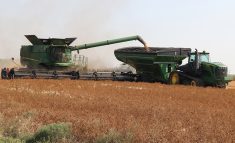Most rural Saskatchewanians are drinking water that smells, tastes or
looks bad, or can cause health problems.
That’s the unanimous conclusion of three water experts at last month’s
annual meeting of the Saskatchewan Conservation and Development
Association Inc.
“More than 300,000 Saskatchewan people are relying on private wells and
99.6 percent of those wells exceed provincial guidelines,” said Darrell
Corkal of the Prairie Farm Rehabilitation Administration.
He said the problems are mainly related to odour or clarity. But a
Read Also

Alberta honey business ‘thrives’ despite bumpy beginnings
Thrive Honey showcases its honey production in market where Alberta produces 40 per cent of all honey produced in the country
third of them represent serious health concerns, with bacteria,
parasites or toxic levels of minerals in the water.
He told rural municipal councillors at the meeting that a PFRA survey
showed most rural people rarely test their water. But they are becoming
more aware of the effects of poor water on their health, their
livestock and crops.
The trouble is that farmers are “financially constrained,” said Corkal.
“It would cost $5,000-$10,000 for every farm house to get drinking
water of city quality. That is a hurdle for most farmers.”
After listening to the presentation, Shirley Jacob, a delegate from
Weyburn, said, “I believe there is an issue … people are not doing
enough testing.”
There is no co-ordination of water testing, said speaker Norma Rueker
of the Safe Drinking Water Foundation. The public health department
checks for the presence of nitrates and coliform bacteria, which can
sicken people and animals. Other tests can be done by the Saskatchewan
Research Council, and Sask Water will check for 36 different elements.
Rueker said the latter offers a good deal, charging only $100 for $450
worth of analysis.
“Sending your water out to test for coliforms once every three years is
no longer good enough,” said Rueker.
She said prevention of contamination is cheaper than treating an
illness later. Her charitable group is trying to educate people about
the need to do more testing and research. Prairie water quality is
worsening, she said, because of increased economic activity, the
changing climate and poor management of water that is available.
Five years ago, Sask Water started offering to test private wells for
$100. Tests can be done as often as a well owner is willing to pay the
fee. Joanne Sketchell of the agency’s rural water quality services
program said 1,034 wells were tested from November 1997 to September
2001. She studied the results and said four major problems could be
seen.
- A third of the wells had higher coliform bacteria levels than is
allowed. These were mainly in shallow wells, less than 30 metres deep.
- Nitrates exceeded the provincial standard in 14 percent of the wells,
again mainly in the shallow ones. This finding is similar to test
results in Ontario and Alberta, she said. Contamination is due to a
variety of factors – 38 percent from livestock manure, eight percent
from the wooden cribbing lining the well, four percent from impure
surface water flowing into the well and 34 percent had no obvious cause.
- Selenium levels were too high in 10 percent of the wells and were a
special problem in southwestern Saskatchewan, where the mineral can
adversely affect cattle.
- Arsenic was too high in 6.3 percent of the wells and showed a
concentration in the province’s northeast.
Sketchell said Saskatchewan’s water is “highly mineralized.” Excess
iron was present in 45 percent of the samples and manganese in 70
percent. Besides tasting bad, water that has lots of minerals can
stain laundry, dishes and teeth or act as a laxative for people and
animals.
Health problems arise when wells are poorly located, such as beside
corrals, or in a land depression so surface runoff drains into a well
rather than away from it. Fibreglass cribbing is recommended rather
than wood or galvanized steel.
Not only present wells pose a problem. There are safety hazards with
abandoned and open wells. Corkal said the PFRA looked at records for
one rural municipality that showed it had 819 wells in 1936. Current
records show 286 wells with132 still being used, while 53 were
abandoned and sealed. He said he doesn’t know what became of the other
wells.
Unmaintained wells are unsealed open holes that could contaminate the
aquifer, he said.
Surface water can be tainted when farm chemicals drift or when cattle
wade into dugouts and streams to drink. Corkal said livestock should
always be watered by remote access. A test at the Termuende research
farm in central Saskatchewan showed that cattle that drank directly
from the dugout were 20 percent lighter than cattle that drank from a
waterer away from the dugout.
Another issue is that all levels of government regulate water, but the
private landowner is ultimately responsible for the quality of his own
water.
“If society takes water for granted, there will be problems in the
future,” Corkal said.
















